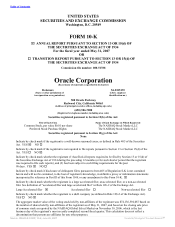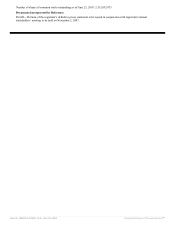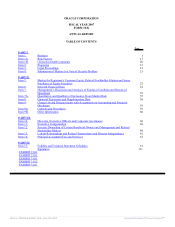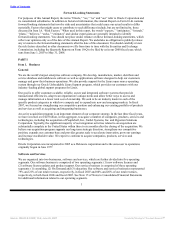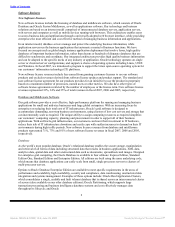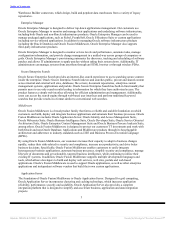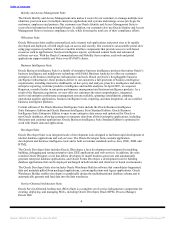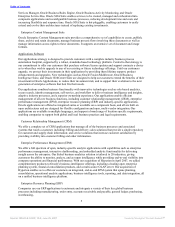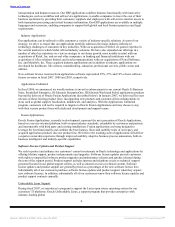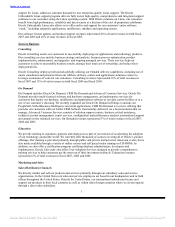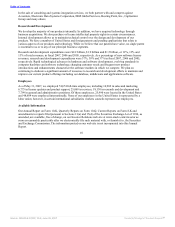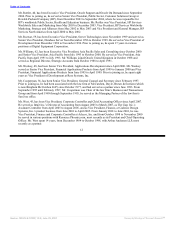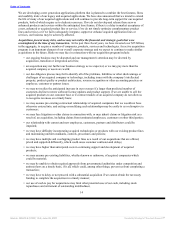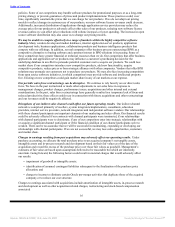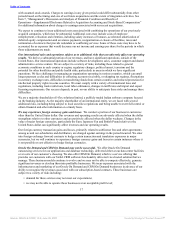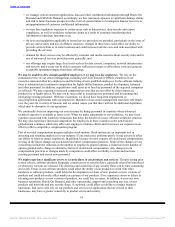Oracle 2006 Annual Report Download - page 12
Download and view the complete annual report
Please find page 12 of the 2006 Oracle annual report below. You can navigate through the pages in the report by either clicking on the pages listed below, or by using the keyword search tool below to find specific information within the annual report.
Table of Contents
We also market our products worldwide through indirect channels. The companies that comprise our indirect
channel network are members of the Oracle PartnerNetwork. The Oracle PartnerNetwork is a global program
that manages our business relationships with a large, broad- based network of companies, including
independent software vendors, system integrators and resellers who deliver innovative solutions and services
based upon our products. By offering our partners’ access to our premier products, educational information,
technical services, marketing and sales support, the OPN program extends our market reach by providing our
partners with the resources they need to be successful in delivering solutions to customers globally.
International Markets
We sell our products and provide services worldwide. Our geographic coverage allows us to draw on business
and technical expertise from a worldwide workforce, provides stability to our operations and revenue streams
to offset geography-specific economic trends and offers us an opportunity to take advantage of new markets
for products. A summary of our domestic and international revenues and long-lived assets is set forth in
Note 15 of Notes to Consolidated Financial Statements.
Cyclicality and Seasonality
General economic conditions have an impact on our business and financial results. The markets in which we
sell our products and services have, at times, experienced weak economic conditions that have negatively
affected revenues. Our quarterly results reflect distinct seasonality in the sale of our products and services, as
our revenues are typically highest in our fourth fiscal quarter and lowest in our first fiscal quarter. See
“Quarterly Results of Operations” in Item 7 for a more complete description of the cyclicality and seasonality
of our revenues and expenses.
Customers
Our customer base consists of a significant number of businesses of many sizes and industries, government
agencies, educational institutions and resellers. No single customer accounted for 10% or more of revenues in
fiscal 2007, 2006 or 2005.
Competition
The enterprise software industry is intensely competitive and evolving rapidly. We compete in various
segments of this industry including database software, middleware (business intelligence, application
integration, portal server, J2EE application server, development tools and identity management),
collaboration, development tools, enterprise applications, consulting/systems integration and operating
systems, among others. Total cost of ownership, performance, functionality, ease of use,
standards-compliance, product reliability, security and quality of technical support are key competitive factors
that face us in each of the areas in which we compete. Our customers are also demanding less complexity and
lower cost in the implementation, sourcing, integration and ongoing maintenance of their enterprise software,
which has led increasingly to our product offerings (database, middleware and applications) being viewed as a
“stack” of software designed to work together. Our product sales (and the relative strength of our products
versus our competitors) are also affected by the broader “platform” competition between industry standard
Java (J2EE) and Microsoft Corporation’s .NET programming environments and by operating system
competition between Windows Server, Unix (Sun Solaris, HP-UX and IBM AIX) and Linux. Open source
alternatives to commercial software, such as MySQL AB in database, Red Hat, Inc. (JBoss) in middleware,
and SugarCRM Inc. in applications, are also impacting the competitive environment. These products are
typically offered free of charge and are readily available over the internet. Finally, “on demand” offerings,
such as those from salesforce.com, continue to alter the competitive landscape.
In the sale of database software and related tools, scalability, reliability, availability and security are key
competitive differentiators for us. Our competitors include International Business Machines Corporation
(IBM), Microsoft, Sybase, Inc., NCR Corporation’s Teradata division, SAS Institute, Inc., Informatica
Corporation, and the open source databases, MySQL and PostgreSQL, among others. Our ability to
continually innovate and differentiate our database offering has enabled us to maintain our leading position in
database software over our competitors.
8
Source: ORACLE CORP, 10-K, June 29, 2007 Powered by Morningstar® Document Research℠


